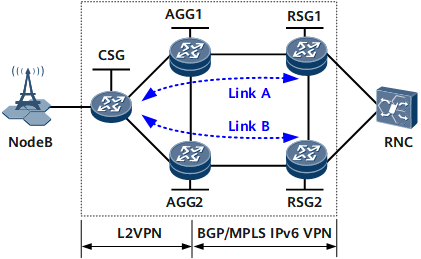Configuring an IPv6 Direct Route to Respond to L3VE Interface Status Changes After a Delay
This section describes how to configure an IPv6 direct route to respond to Layer 3 Virtual Ethernet (L3VE) interface status changes after a delay. During traffic switchback after an L3VE interface recovers, this configuration can reduce traffic loss and improve network reliability.
Applicable Environment
As shown in Figure 1, a Layer 2 virtual private network (L2VPN) connection is set up between each access aggregation gateway (AGG) and the cell site gateway (CSG) through Layer 2 Virtual Ethernet (L2VE) interfaces, while BGP virtual private network version 4 (VPNv4) peer relationships are set up between AGGs and radio network controller site gateways (RSGs) on a Layer 3 virtual private network (L3VPN). L3VE interfaces are configured on AGGs and VPN instances are bound to the L3VE interfaces, so that the CSG can access the L3VPN. BGP is configured on AGGs to import direct routes between the CSG and AGGs. These direct routes are converted to BGP VPNv6 routes and advertised to RSGs.

AGG1 is used as the master device in the preceding figure. In normal cases, RSGs select routes advertised by AGG1 and traffic travels along LinkA. If AGG1 or the CSG-AGG1 link fails, traffic is switched over to LinkB. After AGG1 or the CSG-AGG1 link recovers, the L3VE interface on AGG1 goes from Down to Up, and AGG1 immediately generates an IPv6 direct route destined for the CSG and advertises the route to RSGs. Downstream traffic is then switched over to LinkA. However, AGG1 has not learned the MAC addresses of the base stations yet, so downstream traffic will be lost.
After you configure a cost for an IPv6 direct route and allow the direct route to restore its default cost 0 after a delay, when the L3VE interface on AGG1 goes from Down to Up, the cost of the direct route between the CSG and AGG1 is modified to the configured cost. In this case, RSGs do not select routes advertised by AGG1 and downstream traffic still travels along LinkB. After the configured delay expires, the cost of the direct route to the CSG is restored to the default value 0. Then, RSGs select routes advertised by AGG1 and downstream traffic is switched over to LinkA. At this time, AGG1 has learned the MAC addresses of the base stations, and downstream traffic loss will be reduced.
Pre-configuration Tasks
Before you configure an IPv6 direct route to respond to L3VE interface status changes after a delay, complete the following task:
Configure link-layer protocol parameters and IPv6 addresses for interfaces to ensure that the link layer protocol of each interface is up.
Procedure
- Run system-view
The system view is displayed.
- Run interface virtual-ethernet interface-number
A VE interface is created, and the VE interface view is displayed.
- Run ve-group ve-group-id l3-access
The VE interface is configured as an L3VE interface and bound to a VE-group.

The L2VPN can access the L3VPN only if the L2VE and L3VE interfaces are bound to the same VE-group and reside on the same board.
- Run quit
Return to the system view.
- Run interface virtual-ethernet interface-number.subinterface-number
A VE sub-interface is created, and the VE sub-interface view is displayed.
- Run ipv6 enable
The IPv6 capability is enabled on the interface.
- Run direct-route ipv6 degrade-delay delay-time degrade-cost cost
The direct route is configured to respond to L3VE interface status changes after a delay.
After you run the direct-route ipv6 degrade-delay command on an L3VE interface, and the L3VE interface goes from Down to Up, the cost of the L3VE interface's direct route to the CSG is modified to the configured cost. After the configured delay-time expires, the direct route cost is restored to the default value 0.

The dircet-route ipv6 degrade-delay command and the direct-route ipv6 track pw-state command cannot be all configured on one L3VE interface.
- Run commit
The configuration is committed.
Checking the Configurations
If an AGG's L3VE interface goes from Down to Up, run the display ipv6 routing-table vpn-instance vpn-instance-name [ ipv6-address ] [ verbose ] command on the AGG. The command output shows that the cost of the L3VE interface's IPv6 direct route to the CSG is the configured cost. After the configured delay-time expires, run the display ipv6 routing-table vpn-instance vpn-instance-name [ ipv6-address ] [ verbose ] command on the AGG. The command output shows that the cost of the IPv6 direct route to the L3VE interface is the default value 0.